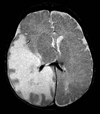Severe hypernatremia in a hospitalized child: munchausen by proxy
- PMID: 20837306
- PMCID: PMC3095029
- DOI: 10.1016/j.pediatrneurol.2010.05.002
Severe hypernatremia in a hospitalized child: munchausen by proxy
Abstract
An 8-week-old infant presented to a referring institution with profuse diarrhea and infectious enteritis for 1 week. He was initially treated for suspected Salmonella spp. sepsis and meningitis, because the organism was found in the stool, but the child's illness progressed, manifested by paroxysmal profuse diarrhea and increased urine output. After several weeks, he suffered a sagittal venous thrombosis and intracranial hemorrhage. Subsequently the child was transferred to a tertiary center for intestinal evaluation. The patient's diarrhea and excessive diuresis resolved, and his sodium normalized soon after transfer. Four days later, however, after his mother arrived, he immediately developed severe hypernatremia (serum sodium concentration [Na(+)] = 214 mEq/L), with resumption of diarrhea and excessive diuresis. A gastric aspirate during the crisis demonstrated an extremely high sodium content, [Na(+)] = 1416 mEq/L, consistent with salt intoxication. Surveillance of the mother revealed that she manipulated the indwelling nasogastric tube; confronted, she admitted to salt administration. This case describes one of the ways that Munchausen syndrome by proxy can manifest with profound neurologic sequelae, and highlights the need for close observation and swift intervention when sufficient cause is present.
Copyright © 2010 Elsevier Inc. All rights reserved.
Figures


Similar articles
-
Munchausen syndrome by proxy: an experience from Nigeria.Ann Trop Paediatr. 1993;13(3):281-4. doi: 10.1080/02724936.1993.11747660. Ann Trop Paediatr. 1993. PMID: 7505555
-
Munchausen by Proxy Syndrome Associated with Fecal Contamination: A Case Report.Turk Psikiyatri Derg. 2020 Fall;31(3):212-215. doi: 10.5080/u25018. Turk Psikiyatri Derg. 2020. PMID: 32978957 English, Turkish.
-
Munchausen by proxy syndrome mimicking childhood-onset systemic lupus erythematosus.Lupus. 2019 Feb;28(2):249-252. doi: 10.1177/0961203318821156. Epub 2019 Jan 7. Lupus. 2019. PMID: 30616452
-
Munchausen syndrome by proxy: a case report.AACN Clin Issues. 2005 Apr-Jun;16(2):178-84. doi: 10.1097/00044067-200504000-00009. AACN Clin Issues. 2005. PMID: 15876886 Review.
-
[Münchausen syndrome by proxy in a forensic psychiatric evaluation--the description of a case and ethical controversy].Psychiatr Pol. 2012 Jul-Aug;46(4):677-89. Psychiatr Pol. 2012. PMID: 23214168 Review. Polish.
Cited by
-
Hypernatremia in an Infant: A Case of Septo-Optic Dysplasia.Cureus. 2021 Jan 3;13(1):e12450. doi: 10.7759/cureus.12450. Cureus. 2021. PMID: 33552768 Free PMC article.
References
-
- Farley TA. Severe hypernatremic dehydration after use of an activated charcoal-sorbitol suspension. J Pediatr. 1986;109:719–722. - PubMed
-
- Finberg L, Kiley J, Luttrell CN. Mass accidental salt poisoning in infancy. A study of a hospital disaster. JAMA. 1963;184:187–190. - PubMed
-
- Paut O, André N, Fabre P, Sobraquès P, Drouet G, Arditti J, Camboulives J. The management of extreme hypernatraemia secondary to salt poisoning in an infant. Paediatr Anaesth. 1999;9:171–174. - PubMed
-
- Meadow R. Munchausen syndrome by proxy. The hinterland of child abuse. Lancet. 1977;310:343–345. - PubMed
-
- American Psychiatric Association. Diagnostic and Statistical Manual of Mental Disorders. 4th ed. Washington, DC: American Psychiatric Association; 1994. p. 475.
Publication types
MeSH terms
Grants and funding
LinkOut - more resources
Full Text Sources
Miscellaneous

